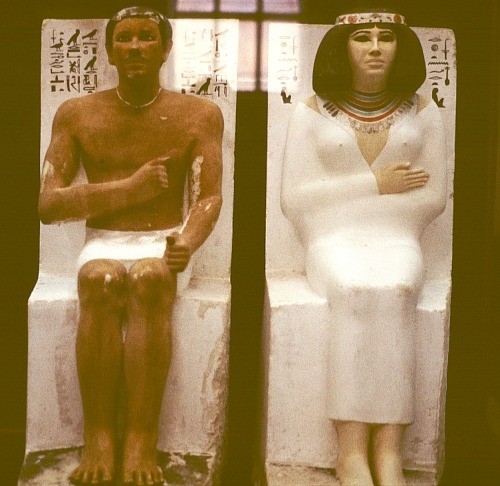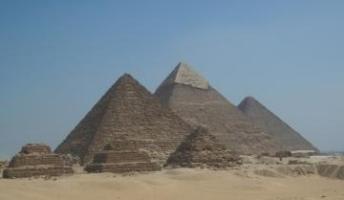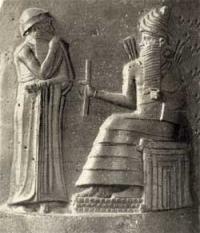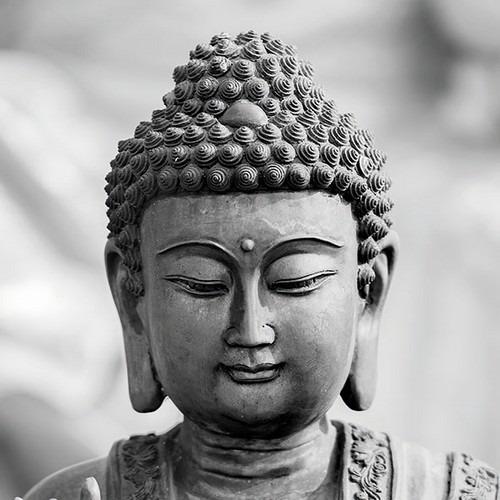Rahotep and Nofret
Of the many notable statuary discovered in Egypt, the two companion statutes of Rahotep and Nofret may be the most remarkable. They are two famous painted limestone figures now on display in the Cairo Museum.

These extraordinary statues are in an excellent state of preservation because the chapels in the mastaba where they were discovered had been sealed off in ancient times, and apparently never opened until the modern discovery. They are in such great condition the colors look almost freshly painted today. The figures are each just over 120 cm high and are seated on high-backed chairs with foot rests.
Rahotep is depicted with his own short black hair. He sports a splendid trimmed black moustache and wears around his neck a single strand necklace with a heart amulet. He wears a short white kilt and has one arm held horizontally across his bare chest. The black painted hieroglyphs on the back of his chair give his name and titles.
Marianne Luban, an Egyptologist, was kind enough to offer a transliteration and English translation of these inscriptions:
| Inscription for Rahotep | |
| Transliteration | Translation |
| wr-m3.w jwnw w .t.y wr zH mDH.w 3ms w .t.y wr js w .t.y wrS pj, nty z3-n.y-sw.t n.y X.t=f r -Htp.j wr n.y pj{.t} jm.y-r3 s-k3j.t Tt jm.y-r3 mS xrp tm3 z3-n.y-sw.t n.y X.t=f r -Htp.j | Unique Chief of Seers of Heliopolis Chief of the Shrine, Keeper of the Scepter He being unique who guards Pe, Bodily Royal Son, Rahotep Chief of Pe Overseer of construction and Vizier Overseer of the Army, Controller of Squadrons Bodily Royal Son, Rahotep |
Nofret wears a shoulder-length dark wig with a circlet decorated with a flower motif around her head. An elegant long white gown enfolds her and shows the straps of another garment beneath, also revealing an elaborate collar. Her arms are folded across her chest. Her titles in hieroglyphs on the back of her chair name her as 'King's Acquaintance'.
The lozenges hanging from the bottom of Nofret's necklace were originally painted green. Perhaps they represent a green stone, although, in their present coloration, one could easily mistake them for diamonds. Diamonds would not be discovered for another 3,000 years.
Refer to the web page at http://www.bluffton.edu/~sullivanm/egypt/cairo/ok.html
Rahotep is painted a reddish-brown color, while Nofret is shown a creamy white. This color difference between husbands and wives is called 'canonical' by Egyptologists because it show repeatedly in wall decorations and other statuary throughout Egypt. No one knows the reason. (By using the word 'canonical' scholars give dignity to something they do not understand.) The painted colors were stylized according to artistic standards; the paints do not reflect their actual colors.
Their anatomical features, and probable true colors, would easily make them citizens of modern Europe or North America. They could walk our streets as white people without a second glance.
The statues were discovered in 1871 by Albert Daninos, an assistant to the French explorer and early archeologist, Auguste Mariette. Their burial in a mastaba located near the pyramid of Meidum shows they were members of the royal family of the Fourth Dynasty. Since it is believed Sneferu built the pyramid scholars assume they were his children, but this had not been verified from existing records. The title given to Nofret might imply she was not a member of the royal family.
The most outstanding feature of the statues is that they both retain their lifelike inlaid eyes of crystal which stunned the Egyptian workmen who first opened the tomb and saw them staring out. In the torch light of the dark tomb they looked alive. The workmen fled in terror.


In attempt to show the color of the eyes I offer these repeated illustrations. The rock crystal used for the eyes was a blue-violate color.
Note that the appearance of the painted skin colors varies according to the photographic process.
A technical description of the manufacture of the eyes was offered by Jay Enoch from the School of Optometry at the University of California at Berkeley. Following are excerpts from a lecture he presented to the American Research Center in Egypt, from Northern California. The summary was provided by Al Berens.
Remarkable Old Kingdom Lenses and the Illusion of the Following Eye
A Recent Analytical Study of Egyptian Statuary at the Louvre
This lecture was based on research Dr. Enoch undertook at the Louvre on the famous seated scribe statue (E-3023) and a “reserve eye” from Saqqara (E-3009) from their collections along with other observations made on pieces found at the Louvre and the Egyptian Museum in Cairo.These pieces share the common feature of the “illusion of the following eye” best observed at the museums when observing these statues with the aid of a pocket flashlight. Trained as an optical specialist, Dr. Enoch consulted an impressive list of other optical specialists and many noted Egyptologists, including Berkeley’s own Dr. Kathleen Keller and Dr. Carol Redmount trying to turn up answers to this interesting puzzle.
These early lenses appear fully formed about 2600-2575 BC at Meidum in the famous statues of Rahotep and his wife Nofret and reappear sporadically in small statuary throughout the Fourth and Fifth Dynasties. The peak of development of these lenses was reached circa 2475 BC. The last Old Kingdom example being that of Mitri. Another Fifth Dynasty statue, that of the funerary Priest Kaemked, had eye structures where the rock crystal lenses were replaced with obsidian, a dark volcanic glass. In the Sixth Dynasty, there are no known examples of these eye structures. These elegant lenses/eyes then reappeared in a single example in the First Intermediate period, the statue of King Hor found at Saqqara, circa 1750 BC.
King Hor
Note the intensity of the blue eyes.

Continuing with the lecture by Jay Enoch:
The composition of these eyes is a lens of polished rock crystal (either alpha silica or fused silica, formerly known as crystalline quartz and fused quartz which had a convex front surface and a near hemispherical concave ground pupil surface in a flat iris plane (normally covered with resin) at the rear of the lens. The white of the eye (the sclera) was carved/ground in white limestone, cloudy or translucent quartz, or marble, some of the latter contained impurities which simulate the conjunctive capillaries of the eye. These are set into the statue in copper (early forms) or bronze (late form) structures which simulate painted eyelids. they are said to sweep back to form a retina-like surface. Resins sometimes partially or fully obscure the pupillary aperture. This type of eye structure is known as a form of “schematic eye”. The structures of these eyes indicate at a minimum a very advanced understanding of the anatomy of the eye for that time. With the exception of the statue of Mitri (Fifth Dynasty), the eyes are well suited to the facial structures of the statues and Mitri’s eyes may represent a medical condition with which he was afflicted or a stylistic change.
The early examples of Nofret and Rahotep have well developed pupillary structures with thick lenses and a point as part of the pupillary concave ground rear lens, as did the reserve eye E-3009. The statue of King Hor has a ring in that ground surface instead of a point and the lens seems not as clear. Dr. Enoch noted that Late Period lenses found by Flinders Petrie at Tanis are simply not in the same class as these much earlier examples. The grinding and polishing of these eye lenses appear to be done in pairs, perhaps from the same larger crystal, and while not exactly the same, each eye is fairly close to the other in execution and their “eye following” ability.Dr. Enoch noted that the quality of these eyes clearly indicates that these could not have been “first attempts” and must represent a development from earlier models which are lost or await discovery. Where did the technologies for these eyes develop and why were they permanently abandoned are important questions which also need further study. Certainly the Egyptians had learned to work hard stones early in their civilization (Dr. Enoch noted there are only limited examples of quartz beads, a quartz “whiskey-like shot glass” and a carved quartz lion in the predynastic collections in Cairo) - thus there are few examples of work done on early rock crystal pieces in current Egyptian collections. Could the lens technology have been imported from elsewhere and adapted to Egyptian stone working techniques or were the eye structures themselves imports? These are questions which need to be addressed. Egyptian trade routes extended far beyond its borders in the Old Kingdom and early dynastic period.
The schematic eye may be best studied with a “reserve eye” found in the Louvre (E-3009) since it is not blocked with any resins, the top is open for viewing, looking at the image plane and is not in place in any statue. Where did the materials come from to create this schematic eye and how were they worked? Indications from the snugness of the fit in these eyes suggest they may have been turned on a lathe. Egyptian stone working techniques (shown in a jewelry making scene from the tomb of Mereruka at Saqqara) demonstrate the use of the bow drill for cutting stone, probably with an abrasive such as corundum (found in the Levant in the Cyclades Islands and Anatolia and also from the Indus Valley) or emery sands from Egypt’s own eastern desert. Dr. Enoch pointed out that low speed drilling with an abrasive can easily account for the lenses seen in these statues, perhaps using papyrus stem drills and a slurry of water and emery or “good old-fashioned spit”.
A number of optical and opthalmic tests were performed on the reserve eye and the scribe Accroupi, a number of which worked while others did not. A keratometer (a device normally used for examining the cornea of a real eye) was used to measure the convex lens mirror surface of the lenses, which were shown to have astigmatic errors. It is interesting to note that virtually all ancient lenses demonstrate astigmatism (a structural defect in a lens or eye that prevents light rays from an object from meeting in a single focal point, so the object appears indistinctly formed). The construction of the reserve eye lens results in certain findings which are very close to real human eyes. The image of the pupil of a real eye lies at circa 3.6 mm from the front surface while the image of the pupil of the schematic reserve eye lies at circa 4.6/4.7 mm. Direct measurement of the reserve eye diameter was 14.33 mm, while photographic records of the schematic eye measured 14.2 mm - a remarkable concurrence of measurements, all things considered. The pupil image was circa 1/4 of the diameter of the front lens of the schematic eye. The illusion of the following eye results from a form of image parallax, that is, the main factor is the appearance of the location of the pupil image perceived as you move around the eye structure.
Dr. Enoch’s team was unable to measure the birefringence (double refracting property) of these rock crystal lens elements. The technique used was not meant for so thick a lens element. The thickness of these lenses proved a surprise! These lens/eye structures were clearly designed to enhance the eye following illusion, and were not meant to wholly mimic real eye structures. These creations utilize defined convex and concave surfaces. Of the pieces examined by Dr. Enoch, the seated scribe from the Louvre has the finest “eye following” ability.
This line of inquiry opens up as many areas of study as it answers. Dr. Enoch reiterated his amazement at the technological achievements these schematic eyes represent, particularly at such an early period in human culture. He knows of no other lenses with these unique “eye following” abilities, past or present. That these lenses were so unique, so well constructed and polished, and so complex suggests that these oldest lenses were not the first lenses.
Egyptologists have not solved the riddle of the technology used for such life-like creations.
The smooth polishing of the eyes of Rahotep and Nofret, and the examples from King Hor and the Louvre, require fine abrasive materials, such as emery sand or corundum. Then the circular regularity noted by Jay Enoch required turning on a rotational instrument that held a constant radial distance. It seems difficult to conceive that such regularity on such hard materials requiring countless rotations would have been held by hand devices, as illustrated in later eras.That is the problem Petrie faced when he found hard materials, such as granite, that could have been produced only by a mechanical rotational device not subject to hand control.































